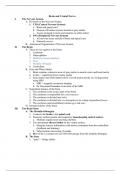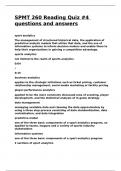-
1. Exam (elaborations) - Ati proctored mental health retake 2019/70 questions and answers
-
2. Exam (elaborations) - Ati mental health 2019/74 questions with complete answers
-
3. Exam (elaborations) - Nursing community/mental health/60 questions with 100% accurate answers
-
4. Exam (elaborations) - Ancc® pmhnp psych-mental health np_test 1 with complete answers
-
5. Exam (elaborations) - Ati mental health proctored exam/156 questions and answers
-
6. Exam (elaborations) - Mental health ati /135 questions with complete solutions
-
7. Exam (elaborations) - Psych/mental health ati practice exam 1/42 q & a/2023
-
8. Exam (elaborations) - Mental health ati exam 1/34 answered questions /2023
-
9. Exam (elaborations) - Ati mental health questions final/54 questions and answers
-
10. Exam (elaborations) - Ati mental health practice a-60 questions and answers
-
11. Exam (elaborations) - Ati mental health practice tests a & b/120 questions and answers
-
12. Exam (elaborations) - Ati mental health proctored exam review|156 questions and answers
-
13. Exam (elaborations) - Rn ati mental health practice test b 2023/60 questions and answers
-
14. Exam (elaborations) - Ati mental health practice test 1 and 2|80 answered questions a+ graded
-
15. Exam (elaborations) - Ati - mental health proctored exam study guide-935 q and a
-
16. Exam (elaborations) - Ati mental health - chapters 1-32 questions and answers/100% scores
-
17. Exam (elaborations) - Mental health proctored ati|70 question and answers
-
18. Exam (elaborations) - Mental health exam #1 ati questions/25 complete questions and answers
-
19. Exam (elaborations) - Ati mental health proctored exam 2023/73 questions with accurate answers
-
20. Exam (elaborations) - Colorado mental health jurisprudence exam/43 questions and answers
-
21. Exam (elaborations) - Vati mental health - psychosocial integrity quiz-25 questions and answers
-
22. Exam (elaborations) - Rasmussen mental health - exam 3/85 questions and answers
-
23. Exam (elaborations) - Rasmussen mental health exam 3|66 questions with complete solutions
-
24. Exam (elaborations) - Mental health exam 3 rasmussen college|53 questions and answers
-
25. Exam (elaborations) - Mental health exam 3 rasmussen|300 questions and answers
-
26. Exam (elaborations) - Shadowhealth mental health tina jones/130 answered questions
-
27. Exam (elaborations) - Shadow health - mental health post test exam questions and answers
-
28. Exam (elaborations) - Mental health final exam/68 questions and answers
-
29. Exam (elaborations) - Nr 326 mental health final exam study set
-
30. Exam (elaborations) - Nr 326-mental health exam 1
-
31. Exam (elaborations) - Nr 326 mental health - exam 2
-
32. Exam (elaborations) - Exam 3 - nr 326, final exam, mental health exam 1 combined notecards, exam 2 mental h...
-
33. Exam (elaborations) - Nr 326 mental health exam 1
-
34. Exam (elaborations) - Mental health exam 1 - practice questions with answers
-
35. Exam (elaborations) - Exam 1 mental health/65 questions and answers 2024
-
36. Exam (elaborations) - Exam #1 mental health/51 accurate questions and answers
-
37. Exam (elaborations) - Mental health practice exam questions and answers
-
38. Exam (elaborations) - Mental health exam #1/133 answered questions with 100% scores
-
39. Exam (elaborations) - Mental health - exam 1 – evolve questions and answers a+ rated
-
40. Exam (elaborations) - Mental health exam #1 (ch 1,2,5,8,9,3,4,6) – questions and answers
-
41. Exam (elaborations) - Mental health practice exam (exam 1) – questions & answers
-
42. Exam (elaborations) - Mental health test review questions with solutions
-
43. Exam (elaborations) - Mental health exam 1|124 answered questions| a+ graded
-
44. Exam (elaborations) - Exam 1 - psychiatric/mental health nursing practice questions and answers
-
45. Exam (elaborations) - Mental health exam 1 pp and practice exam questions & answers
-
46. Exam (elaborations) - Psychiatric-mental health practice exam questions and solutions
-
47. Exam (elaborations) - Nclex questions (mental health exam 1) – q’s and a’s
-
48. Exam (elaborations) - Mental health exam 2 quizlet- practice questions and answers 2024
-
49. Exam (elaborations) - Mental health: exam 1: nclex review questions from evolve website
-
50. Exam (elaborations) - Psych/mental health exit hesi – saunders exam/110 q’s and a’s
-
51. Exam (elaborations) - Psychiatric-mental health practice exam hesi/558 questions and answers
-
52. Exam (elaborations) - Hesi case study - psychiatric/mental health practice exam/75 q/a
-
53. Exam (elaborations) - Hesi psychiatric-mental health practice exam/126 questions & answers
-
54. Exam (elaborations) - Psychiatric-mental health practice exam hesi/75 q’s and a’s
-
55. Exam (elaborations) - Hesi psychiatric/mental health practice test exam/50 questions and answers
-
56. Exam (elaborations) - Ati mental health exam/82 q’s and a’s
-
57. Exam (elaborations) - Ati rn mental health nursing exam questions with answers
-
58. Exam (elaborations) - Ati rn 3.0 mental health 1 exam/40 questions and solutions
-
59. Exam (elaborations) - Ati rn mental health exam 2024 with ngn
-
60. Exam (elaborations) - Ati rn mental health online practice 2024 b/60 q’s and a’s
-
61. Exam (elaborations) - Ati mental health practice test a exam/59 questions and answers
-
62. Exam (elaborations) - Mental health ati - assessment a exam questions with solutions
-
Show more




